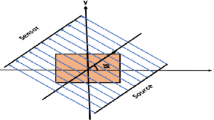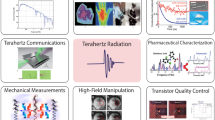Abstract
The increment of communication technologies and the development of signal processing require efficient identification techniques for communication radiation. However, the complex characteristics of electromagnetic environment are not adequately handled by linear methods. Since the fractal theory is well suited for nonlinear problems, the relation of self-similarity (SS) between baseband and modulated signals is studied in this paper. Indeed, the existence of SS’s relation between the baseband and modulated signals is proved and verified under certain conditions. Finally, the analysis and extraction of individual signal fingerprint features in communication radiation source is constructed. Experimental results show that the proposed property SS is effective in the identification and classification of communication radiation sources.





Similar content being viewed by others
References
Antoniou A (2016) Digital signal processing. McGraw-Hill, New York
Ishimaru A (2017) Electromagnetic wave propagation, radiation, and scattering: from fundamentals to applications. John Wiley & Sons, Hoboken
Tarasov VE (2015) Electromagnetic waves in non-integer dimensional spaces and fractals. Chaos, Solitons Fractals 81:38–42
Mandelbrot BB (1982) The fractal geometry of nature. WH freeman, New York
Higuchi T (1988) Approach to an irregular time series on the basis of the fractal theory. Physica D 31(2):277–283
Zhenling L (2013) Fractal theory and application in city size distribution. Inf Technol J 12(17):4158–4162
Cossio M, Moridis G, Blasingame TA (2013) A semianalytic solution for flow in finite-conductivity vertical fractures by use of fractal theory. SPE J 18(01):83–96
Topper B, Lagadec P (2013) Fractal crises–a new path for crisis theory and management. J Conting Crisis Manag 21(1):4–16
Escultura EE (2013) Chaos, turbulence and fractal: theory and applications. Int J Modern Nonlinear Theor Appl 2(03):176
Juan-ping W, Ying-zheng H, Jin-mei Z, et al (2010) Automatic modulation recognition of digital communication signals//Pervasive Computing Signal Processing and Applications (PCSPA), 2010 First International Conference on. IEEE, p 590–593
Yi-bing L, Jing-chao L, Yun L (2011) The identification of communication signals based on fractal box dimension and index entropy. J Converg Inf Technol 6(11):201–208
Li Y, Nie W, Ye F, et al (2014) A pulse signal characteristic recognition algorithm based on multifractal dimension. Math Probl Eng 2014
Li J, Ying Y (2014) Individual radiation source identification based on fractal box dimension//Systems and Informatics (ICSAI), 2014 2nd International Conference on. IEEE, p 676–681
Li B, Chen S, Dong J, et al. (2015) Multi-scale fractal analysis of modulation signals//Sixth International Conference on Electronics and Information Engineering. International Society for Optics and Photonics 9794:979412
Tang Z, Li S (2016) Steady signal-based fractal method of specific communications emitter sources identification//Wireless Communications, Networking and Applications. Springer, New Delhi, p 809–819
Wu L, Zhao Y, Wang Z, et al. (2017) Specific emitter identification using fractal features based on box-counting dimension and variance dimension//2017 IEEE International Symposium on Signal Processing and Information Technology (ISSPIT). IEEE, p 226–231
Guo S, White R E, Low M (2018) A comparison study of radar emitter identification based on signal transients//Radar Conference (RadarConf18), 2018 IEEE. IEEE, p 0286–0291
Yu Y, Baoliang L, Jingshan S, et al (2010) The application of vibration signal multi-fractal in fault diagnosis//Future Networks, 2010. ICFN'10. Second International Conference on. IEEE, p 164–167
Ziaja A, Barszcz T, Staszewski W (2012) Fractal based signal processing for fault detection in ball-bearings//Condition Monitoring of Machinery in Non-Stationary Operations. Springer, Berlin, Heidelberg, p 385–392
Jiao W, Jiang Y, Shi J (2017) Early-stage monitoring on faults of rolling bearings based on fractal feature extraction//Technology, Networking, Electronic and Automation Control Conference (ITNEC), 2017 IEEE 2nd Information. IEEE, p 173–178
Eke A, Herman P, Kocsis L et al (2002) Fractal characterization of complexity in temporal physiological signals. Physiol Meas 23(1):R1
Raghavendra BS, Dutt DN (2010) Signal characterization using fractal dimension. Fractals 18(03):287–292
Azami H, Bozorgtabar B, Shiroie M (2011) Automatic signal segmentation using the fractal dimension and weighted moving average filter. J Electro Comput Sci 11(6):8–15
Rangayyan RM, Oloumi F, Wu Y et al (2013) Fractal analysis of knee-joint vibroarthrographic signals via power spectral analysis. Biomed Signal Proces 8(1):23–29
Paulraj MP, Yaccob SB, Yogesh CK (2014) Fractal feature based detection of muscular and ocular artifacts in EEG signals//Biomedical Engineering and Sciences (IECBES), 2014 IEEE Conference on. IEEE, p 916–921
Zlatintsi A, Maragos P (2013) Multiscale fractal analysis of musical instrument signals with application to recognition. IEEE Trans Audio Speech Lang Process 21(4):737–748
Park JS, Kim SH (2014) Emotion recognition from speech signals using fractal features. Int J Softw Eng Appl 8(5):15–22
Berizzi F, Dalle-Mese E (1999) Fractal analysis of the signal scattered from the sea surface. IEEE Trans Antennas Propag 47(2):324–338
Berizzi F, Dalle-Mese E (2002) Scattering from a 2D sea fractal surface: fractal analysis of the scattered signal. IEEE Trans Antennas Propag 50(7):912–925
Wang C, Xu J, Zhao X et al (2012) Fractal characteristics and its application in electromagnetic radiation signals during fracturing of coal or rock. Int J Min Sci Technol 22(2):255–258
Maragos P, Sun FK (1993) Measuring the fractal dimension of signals: morphological covers and iterative optimization. IEEE Trans Signal Process 41(1):108
Raghavendra BS, Dutt DN (2010) Computing fractal dimension of signals using multiresolution box-counting method. International Journal of Information and Mathematical Sciences 6(1):50–65
Xie Z, Zhai M, Liu X (2017) Research on fractal characteristics of broadband power line communication signal//Wireless Communications, Signal Processing and Networking (WiSPNET), 2017 International Conference on. IEEE, p 373–378
Ma YJ, Zhai MY (2018) Fractal and multi-fractal features of the broadband power line communication signals. Comput Electr Eng
Karagiannis T, Faloutsos M (2002) SELFIS: A tool for self-similarity and long-range dependence analysis//1st workshop on Fractals and Self-Similarity in Data Mining: Issues and Approaches (in KDD)
Hurst HE (1951) Long-term storage capacity of reservoirs. Trans Am Soc Civ Eng 116:770–799
Peters EE, Peters D (1994) Fractal market analysis: applying chaos theory to investment and economics. John Wiley & Sons, Hoboken
Acknowledgments
The research is supported by the Open Project Program of the State Key Laboratory of Complex Electromagnetic Environment Effects on Electronics and Information System under Grant 2019K0104B.
Author information
Authors and Affiliations
Corresponding author
Additional information
Publisher’s Note
Springer Nature remains neutral with regard to jurisdictional claims in published maps and institutional affiliations.
Rights and permissions
About this article
Cite this article
Liu, S., Bai, W., Srivastava, G. et al. Property of Self-Similarity Between Baseband and Modulated Signals. Mobile Netw Appl 25, 1537–1547 (2020). https://doi.org/10.1007/s11036-019-01358-9
Published:
Issue Date:
DOI: https://doi.org/10.1007/s11036-019-01358-9




